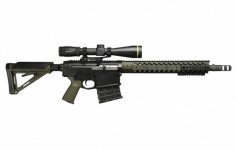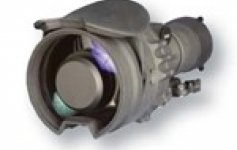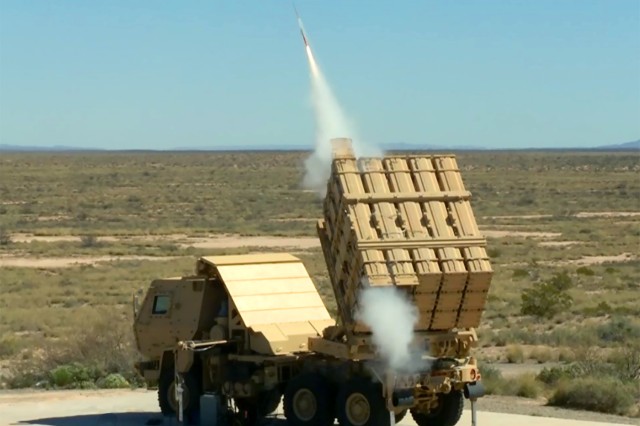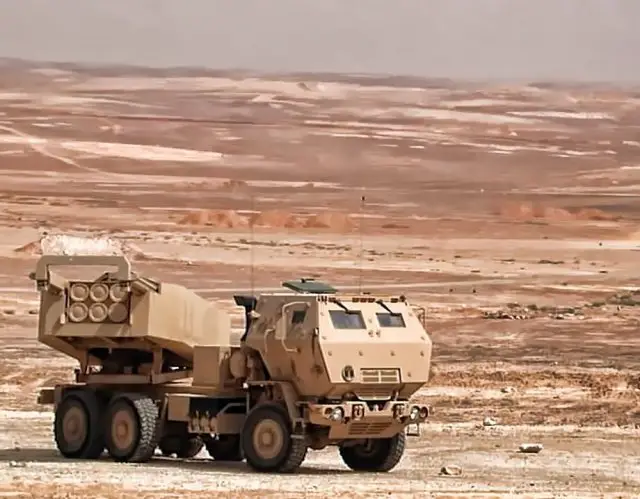- Reaction score
- 2,227
- Points
- 1,160
http://www.foxnews.com/tech/2016/03/09/army-tests-high-tech-airdrop-system-that-sees-its-target.html?cmpid=NL_SciTech
Army tests high-tech airdrop system that 'sees' its target
By James Rogers Published March 09, 2016 FoxNews.com
The U.S. Army is testing a high-tech airdrop system that uses a sophisticated video navigation system to locate its target. The system could prove invaluable for airdrops in difficult terrain and urban environments, researchers say.
The military has been working for years to boost the accuracy of its airdrops when resupplying troops. As part of this effort, the Joint Precision Airdrop System (JPADS), which uses GPS, an onboard computer and a steerable parachute, was developed in 2006. The technology was deployed in the field three years – it accounted for about 1 percent of the total airdrops conducted by the U.S. Air Force in Afghanistan.
Now, the U.S. Army Natick Soldier Research, Development and Engineering Center (NSRDEC) is working on an even more accurate airdrop alternative to GPS as part of an ambitious multi-service project.
"In some terrains, such as steep canyons, or urban settings with tall buildings, you can lose GPS - these are gliding systems, so they can't fly up in altitude." Richard Benney, Director of the Aerial Delivery Directorate at NSRDEC, told FoxNews.com. “We're researching and testing what we call a video navigation system – currently it's simply a camera that's looking down and out towards the ground in the direction of flight."
Benney explained that the video navigation system picks up ‘targets,’ such as reference points or features in the local landscape. “We will probably feed the JPADS an image just before it's deployed out of the aircraft from the USAF JPADS mission planner,” he said. “The image can come from a satellite, UAS [Unmanned Aerial System] or other sources - it will tell the JPADS 'your job is to land on that pixel'.”
The as-yet unnamed video navigation system is currently being tested in desert environments and there are plans to upgrade the JPADS fleet with the new technology over the next three to five years.
The video navigation technology will eventually guide a wide range of payloads to their intended targets. There are two variants of JPADS – a 2K version that handles weights from 700 pounds up to 2,200 pounds and a 10K version for weights from 5,000 pounds to 10,000 pounds.
Benney explained that 2Ks can be dropped from as low as 3,500 feet and up to 25,000 feet, whereas 10Ks are dropped between 18,000 and 25,000 feet.
Cambridge, Massachusetts-based Draper Lab, under contract with the U.S. Army, developed the JPADS flight software and is one of the lead partners on the flight vision software.
Initial indications suggest that video navigation airdrops offer an extremely high level of accuracy. “The 2K requirement is to be within 150 meters [492 feet] of the target, but it's considerably better than that,” Benney told FoxNews.com. “[The] 10K target is [to be within] 250 meters [820 feet] for the target, but it's significantly better than that."
Follow James Rogers on Twitter @jamesjrogers
New tech gives US helicopter pilots 'Superman-style' vision
By Allison Barrie Published March 03, 2016 FoxNews.com
New technology means U.S. military helicopter pilots will be getting amped-up ‘Superman-style’ vision to help them tackle dangerous environments.
One of the biggest threats to aircraft is Degraded Visual Environment or DVE. New technology made by Honeywell aims to solve this problem.
Superman’s vision lets him see through things and observe high detail. DARPA, the Defense Advanced Research Projects Agency, has issued a contract to Honeywell to create tech enabling helicopter pilots to deal with extreme DVE and “See” crucial details. The tech is called synthetic vision. Honeywell has been developing and testing it with DARPA for more than nine years.
U.S. Military helicopters like the UH-60 Black Hawk will be outfitted with the Synthetic Vision Avionics Backbone (SVAB) for testing.
The threat
When visibility is degraded it can mask hazards lurking in bad weather like rain, snow, dust and fog. These challenges can cause low visibility, making it tough to land and fly.
“Brown-out" is a condition that military pilots regularly face when terrain becomes obscured, particularly in desert conditions such as those experienced in Iraq and Afghanistan.
When a pilot approaches a landing zone in a desert environment it often becomes a brown out when sand, dirt and dust gets kicked up. In a brown-out, the pilot loses his or her visual reference with the ground. The airframe can drift and collide with the ground or other structures causing the helicopter to land hard or even roll over.
How does it work?
Honeywell's technology provides pilots with a 3-D view of the landing zone on their flight displays. The synthetic vision system integrates data from a number of state-of-the-art sensors. These data are fused together, processed and translated into a picture of the area around the pilot.
The technology aims to show dangers like other aircraft, telephone wires, vehicles and personnel near the landing zone as well as unexpected terrain hidden by dust or other aspects of DVE.
Ultimately, military pilots could have such enhanced vision that even small holes and ditches around the landing zone will be revealed.
The tech could help save lives as well as reduce costs. Pentagon research estimates place the damage and loss of U.S. military aircraft due to degraded visual environments in the hundreds of millions of dollars.
Many companies have been trying to find a solution to DVE. Tech touted to tackle the problem includes millimeter wave radar, infrared radar, long wave and LIDAR, a laser-based surveying technology.
Advanced military aircraft like the CH 47 F-model Chinook, AH-64 Block III Apache attack helo and the Black Hawk UH-60 M-model already give pilots enhanced support when equipped with cutting edge moving map displays and digital flight controls.
How does it work?
In the next phase of the Multifunction Radio Frequency program, Honeywell will update the synthetic vision system to fuse information from DARPA's Advanced Rotary Multifunction Sensor radar, along with satellite imagery and databases of terrain and obstacles.
DVEs are a big challenge for all militaries, but with this technology US pilots would have the advantage of being able to safely operate where others cannot.
Ballet dancer turned defense specialist Allison Barrie has traveled around the world covering the military, terrorism, weapons advancements and life on the front line. You can reach her at [email protected] or follow her on Twitter @Allison_Barrie.
Army tests high-tech airdrop system that 'sees' its target
By James Rogers Published March 09, 2016 FoxNews.com
The U.S. Army is testing a high-tech airdrop system that uses a sophisticated video navigation system to locate its target. The system could prove invaluable for airdrops in difficult terrain and urban environments, researchers say.
The military has been working for years to boost the accuracy of its airdrops when resupplying troops. As part of this effort, the Joint Precision Airdrop System (JPADS), which uses GPS, an onboard computer and a steerable parachute, was developed in 2006. The technology was deployed in the field three years – it accounted for about 1 percent of the total airdrops conducted by the U.S. Air Force in Afghanistan.
Now, the U.S. Army Natick Soldier Research, Development and Engineering Center (NSRDEC) is working on an even more accurate airdrop alternative to GPS as part of an ambitious multi-service project.
"In some terrains, such as steep canyons, or urban settings with tall buildings, you can lose GPS - these are gliding systems, so they can't fly up in altitude." Richard Benney, Director of the Aerial Delivery Directorate at NSRDEC, told FoxNews.com. “We're researching and testing what we call a video navigation system – currently it's simply a camera that's looking down and out towards the ground in the direction of flight."
Benney explained that the video navigation system picks up ‘targets,’ such as reference points or features in the local landscape. “We will probably feed the JPADS an image just before it's deployed out of the aircraft from the USAF JPADS mission planner,” he said. “The image can come from a satellite, UAS [Unmanned Aerial System] or other sources - it will tell the JPADS 'your job is to land on that pixel'.”
The as-yet unnamed video navigation system is currently being tested in desert environments and there are plans to upgrade the JPADS fleet with the new technology over the next three to five years.
The video navigation technology will eventually guide a wide range of payloads to their intended targets. There are two variants of JPADS – a 2K version that handles weights from 700 pounds up to 2,200 pounds and a 10K version for weights from 5,000 pounds to 10,000 pounds.
Benney explained that 2Ks can be dropped from as low as 3,500 feet and up to 25,000 feet, whereas 10Ks are dropped between 18,000 and 25,000 feet.
Cambridge, Massachusetts-based Draper Lab, under contract with the U.S. Army, developed the JPADS flight software and is one of the lead partners on the flight vision software.
Initial indications suggest that video navigation airdrops offer an extremely high level of accuracy. “The 2K requirement is to be within 150 meters [492 feet] of the target, but it's considerably better than that,” Benney told FoxNews.com. “[The] 10K target is [to be within] 250 meters [820 feet] for the target, but it's significantly better than that."
Follow James Rogers on Twitter @jamesjrogers
New tech gives US helicopter pilots 'Superman-style' vision
By Allison Barrie Published March 03, 2016 FoxNews.com
New technology means U.S. military helicopter pilots will be getting amped-up ‘Superman-style’ vision to help them tackle dangerous environments.
One of the biggest threats to aircraft is Degraded Visual Environment or DVE. New technology made by Honeywell aims to solve this problem.
Superman’s vision lets him see through things and observe high detail. DARPA, the Defense Advanced Research Projects Agency, has issued a contract to Honeywell to create tech enabling helicopter pilots to deal with extreme DVE and “See” crucial details. The tech is called synthetic vision. Honeywell has been developing and testing it with DARPA for more than nine years.
U.S. Military helicopters like the UH-60 Black Hawk will be outfitted with the Synthetic Vision Avionics Backbone (SVAB) for testing.
The threat
When visibility is degraded it can mask hazards lurking in bad weather like rain, snow, dust and fog. These challenges can cause low visibility, making it tough to land and fly.
“Brown-out" is a condition that military pilots regularly face when terrain becomes obscured, particularly in desert conditions such as those experienced in Iraq and Afghanistan.
When a pilot approaches a landing zone in a desert environment it often becomes a brown out when sand, dirt and dust gets kicked up. In a brown-out, the pilot loses his or her visual reference with the ground. The airframe can drift and collide with the ground or other structures causing the helicopter to land hard or even roll over.
How does it work?
Honeywell's technology provides pilots with a 3-D view of the landing zone on their flight displays. The synthetic vision system integrates data from a number of state-of-the-art sensors. These data are fused together, processed and translated into a picture of the area around the pilot.
The technology aims to show dangers like other aircraft, telephone wires, vehicles and personnel near the landing zone as well as unexpected terrain hidden by dust or other aspects of DVE.
Ultimately, military pilots could have such enhanced vision that even small holes and ditches around the landing zone will be revealed.
The tech could help save lives as well as reduce costs. Pentagon research estimates place the damage and loss of U.S. military aircraft due to degraded visual environments in the hundreds of millions of dollars.
Many companies have been trying to find a solution to DVE. Tech touted to tackle the problem includes millimeter wave radar, infrared radar, long wave and LIDAR, a laser-based surveying technology.
Advanced military aircraft like the CH 47 F-model Chinook, AH-64 Block III Apache attack helo and the Black Hawk UH-60 M-model already give pilots enhanced support when equipped with cutting edge moving map displays and digital flight controls.
How does it work?
In the next phase of the Multifunction Radio Frequency program, Honeywell will update the synthetic vision system to fuse information from DARPA's Advanced Rotary Multifunction Sensor radar, along with satellite imagery and databases of terrain and obstacles.
DVEs are a big challenge for all militaries, but with this technology US pilots would have the advantage of being able to safely operate where others cannot.
Ballet dancer turned defense specialist Allison Barrie has traveled around the world covering the military, terrorism, weapons advancements and life on the front line. You can reach her at [email protected] or follow her on Twitter @Allison_Barrie.








